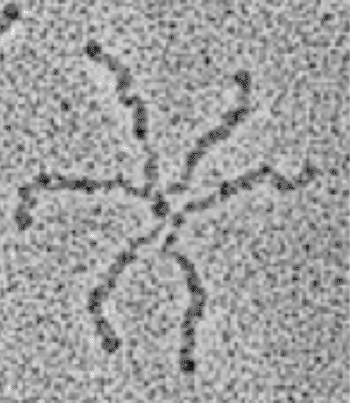Tenascin-C Prevents Postnatal Transmission of HIV by Neutralizing the Virus in Breast Milk
By LabMedica International staff writers
Posted on 31 Oct 2013
A protein that occurs naturally in human breast milk was shown to capture and neutralize HIV virions and protect babies from becoming infected with the virus.Posted on 31 Oct 2013
Achieving an AIDS-free generation will require elimination of transmission of HIV-1 from infected mothers to their babies while maintaining the nutritional and immunologic benefits of breastfeeding for infants in developing regions. Treatment of mothers and infants with antiretroviral drugs can reduce postnatal HIV-1 transmission, yet toxicities and the development of drug-resistant viral strains may limit the effectiveness of this strategy.

Image: Electron microscope image of glycoprotein Tenascin-C (TNC) (Photo courtesy of Dr. Harold Erickson, Duke University).
In 2011, according to the United Nations International Children's Emergency Fund (UNICEF), an estimated 330,000 children acquired HIV from their mothers during pregnancy or birth, or through breastfeeding. Nonetheless, in the absence of antiretroviral drug treatment more than 90% of infants exposed to HIV-1 via breastfeeding remained uninfected, despite daily mucosal exposure to the virus for up to two years. Moreover, milk of uninfected women inherently neutralizes HIV-1 and prevents virus transmission in animal models, yet the factor or factors responsible for this anti-HIV activity are not well defined.
To identify anti-HIV-1 factors in breast milk, investigators at Duke University (Durham, NC, USA) screened mature milk samples from uninfected women for neutralizing activity against a panel of HIV strains. They reported in the October 21, 2013, online edition of the journal Proceedings of the National Academy of Sciences of the United States of America (PNAS) that the glycoprotein Tenascin-C (TNC) was a primary HIV-1–neutralizing protein in breast milk. TNC is an extracellular matrix protein important in fetal development and wound healing, yet its antimicrobial properties had not previously been established.
Purified TNC captured and neutralized chronic and transmitted HIV-1 variants. TNC captured and neutralized HIV-1 virions via binding to the chemokine coreceptor binding site on the HIV-1 envelope. Depletion of TNC abolished the HIV-1–neutralizing activity of milk.
“TNC is a component of the extracellular matrix that is integral to how tissues hold themselves together,” said senior author Dr. Sallie Permar, assistant professor of pediatrics, immunology, molecular genetics, and microbiology at Duke University. “This is a protein involved during wound healing, playing a role in tissue repair. It is also known to be important in fetal development, but its reason for being a component of breast milk or its antiviral properties had never been described. It is likely that TNC is acting in concert with other anti-HIV factors in breast milk, and further research should explore this. But given TNC’s broad-spectrum HIV-1-binding and neutralizing activity, it could be developed as an HIV-prevention therapy, given orally to infants prior to breastfeeding, similar to the way oral rehydration salts are routinely administered to infants in developing regions.”
“Even though we have antiretroviral drugs that can work to prevent mother-to-child transmission, not every pregnant woman is being tested for HIV, and less than 60% are receiving the prevention drugs, particularly in countries with few resources,” said Dr. Permar. “So there is still a need for alternative strategies to prevent mother-to-child transmission, which is why this work is important.”
Related Links:
Duke University














